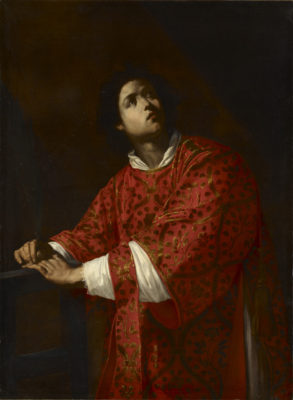Andrea VACCARO
(Naples, 1604-1670)
Saint Lawrence.
C. 1630.
Oil on canvas, 63 x 39 in. (160 x 99 cm).
The painting is in excellent condition, and after recent conservation its formal elements can be read exhaustively. The figure of the saint, standing and robed as a deacon, is shown leaning against a large metal grill, and holds a martyr’s palm in his right hand. Saint Lawrence, born in the Spanish city of Huesca in the year 225 and martyred in Rome on 10 August, 258 (the Catholic Church still celebrates his name on that day), was named by Pope Sixtus II as one of the seven Deacons of the Eternal City, and, according to tradition, and for reasons that are not entirely clear from a historical point of view – perhaps for his charitable activities, or for other motives – he was martyred by being grilled alive.
The canvas, made of a large square weave, is densely prepared, its dark background crossed by a broad, diagonal fall of light and a powerful chiaroscuro that still recalls the poetics of Caravaggio. The vigorous passages of colour set within a carefully crafted design – the red dalmatic stands out splendidly, as do the visible parts of the white tunic – indicate Neapolitan authorship, and a dating between the 1620s and 1630s. At the same time one can note a sense of pathos in the saint’s expression, his eyes turned heavenward to seek divine inspiration in the face of martyrdom – the approach of a painter who was attentive, though in an entirely independent way, to the work of Guido Reni, in his brief Caravaggesque moment.
I believe that an attribution can be established by comparison with the youthful paintings of Andrea Vaccaro. We know from the biographer Bernardo De Dominici that Vaccaro, influenced by Battistello Caracciolo, “found it easy to be dazzled […] by the clamorous new language of Caravaggio. Andrea thus copied a number of pictures by that fantastic painter, soon imitating him so well that these seemed originals, not copies, to the eyes of connoisseurs”. And we know that subsequently, advised by his friend and colleague Massimo Stanzione, Vaccaro turned his attention above all to Guido Reni.
Vaccaro’s early works are little known, and only in recent years have some additions been made to the oeuvre: a copy of Caravaggio’s Flagellation in the church of San Domenico Maggiore, Naples; the David in a Neapolitan private collection; the David Contemplating the Head of Goliath (Florence, Roberto Longhi Foundation); another David (whereabouts unknown); a Saint Sebastian led to Martyrdom (Naples, Perrone Capano collection); and a few other works.
Bologna dates these works to the period 1625-1630, noting their “impronta battistelliana”, or how they are marked by the style of Battistello Caracciolo. To this group we should now add a magnificent pair of pendant subjects, The Martyrdom of Saint Bartholomew and Saint Stephen led to Martyrdom (Otto Naumann), attributed to Andrea Vaccaro for the first time by the present writer in 2009. Suffice it to compare Saint Stephen’s dalmatic in the Naumann canvas with the one depicted in our Saint Lawrence to understand the basis for this attribution to Vaccaro. The objective and extremely calculated description of the position of Saint Lawrence’s hands on the grill, and their careful draughtsmanship, also attest to Vaccaro’s talent in describing form.
The powerful face of the young saint deserves a few words: it is turned upwards to listen to the voice of God, with an expression appropriate to both concentration and inspiration. If, as we have already said, something of Guido Reni’s invention is present in the position of the head and gaze, it is also true that Vaccaro was to revisit such poses, subtly varied, in later works such as the Triumph of David in the Musée d’Art et d’Histoire, Geneva, where the protagonist’s face seems to derive from the same idea as was used in our Saint Lawrence.
If we seek to assign a date to this picture, we could hypothetically suggest the moment around 1630, close to the Saint Bartholomew and Saint Stephen mentioned above. This would mean that our Saint Lawrence is one of the rare early works in the extensive and later prolific oeuvre of Andrea Vaccaro. It is an important addition to his body of work, and its qualities confirm the prime position held by this artist not only in the world of Neapolitan Seicento painting but within a wider Italian context.
Riccardo LATTUADA
